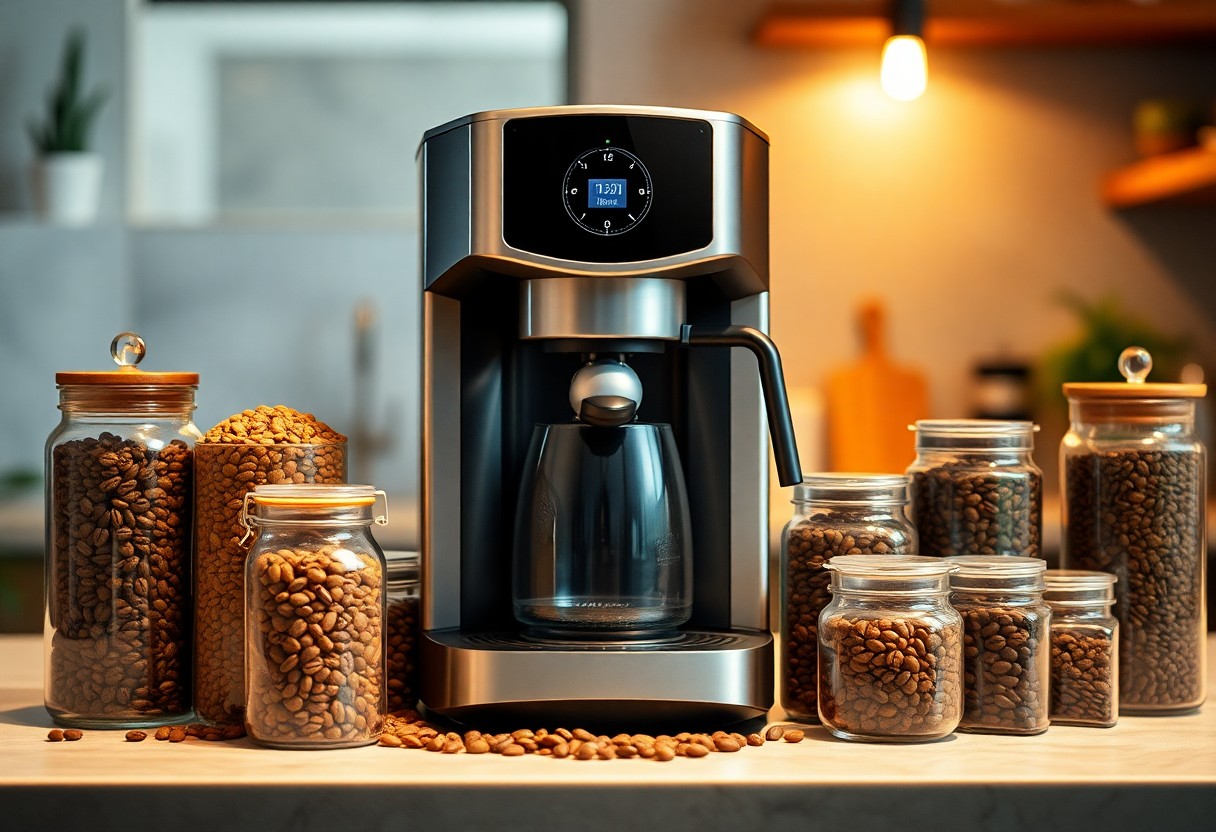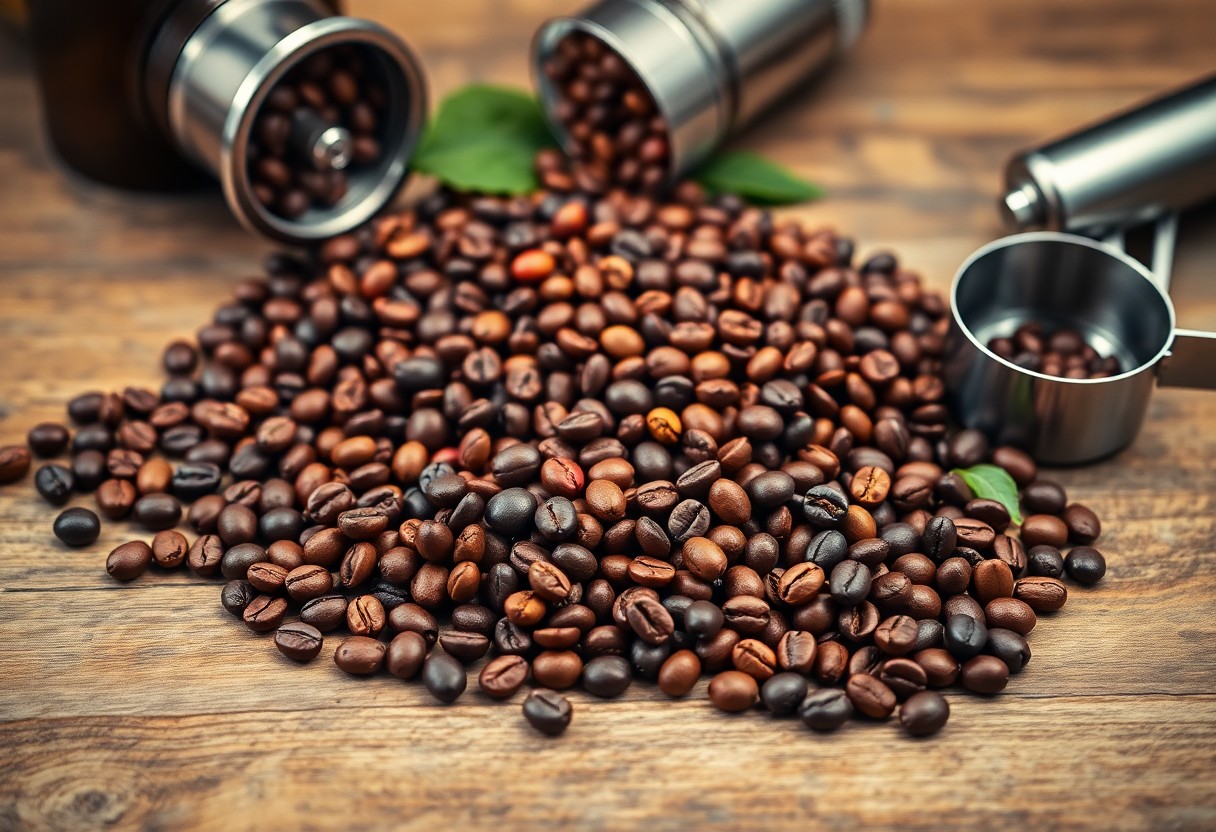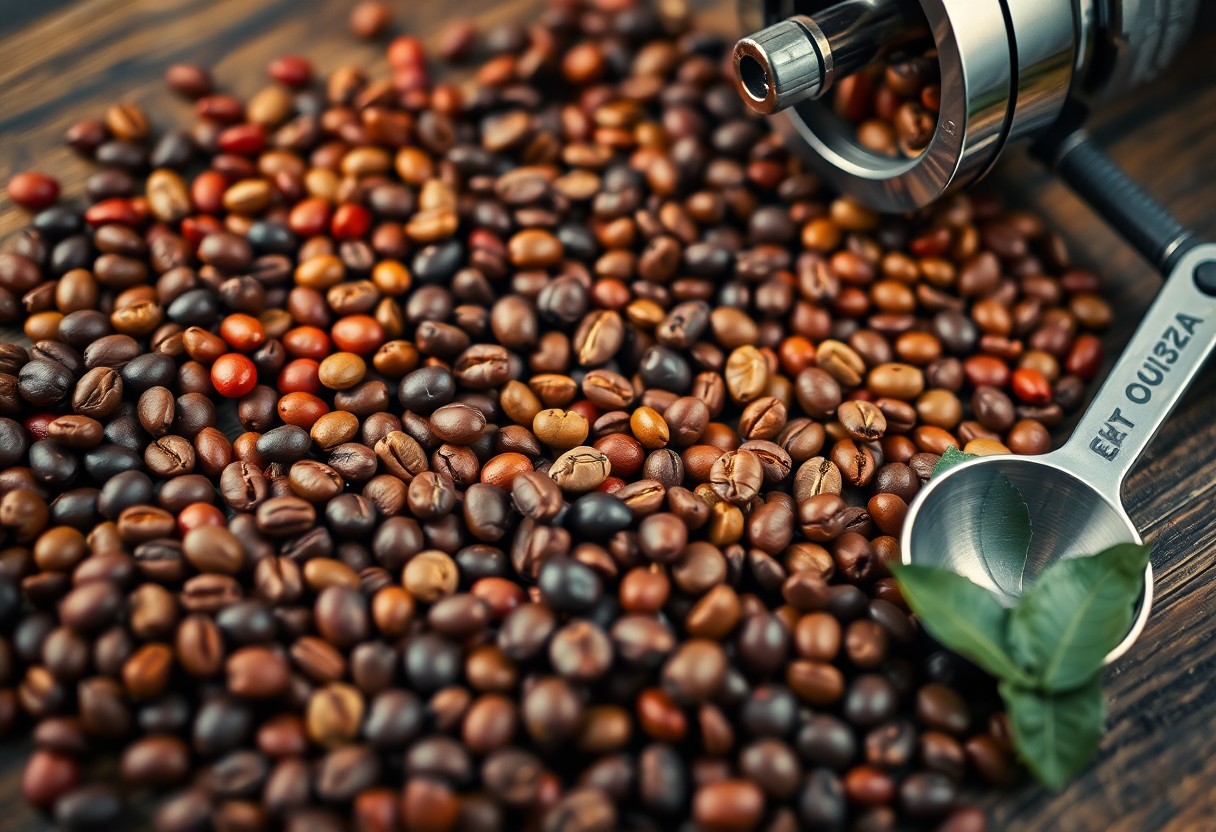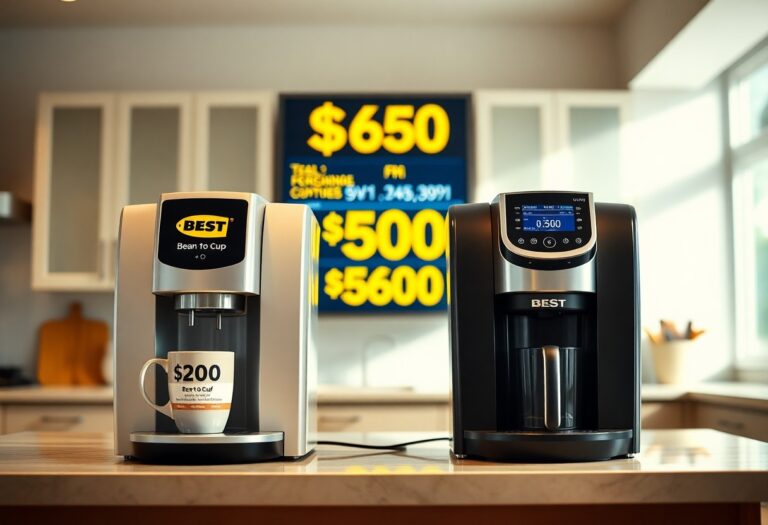What Coffee for a Coffee Machine – General Bean Guide
Many coffee enthusiasts struggle with selecting the right beans for their machines, impacting the flavor and quality of their brews. You deserve to enjoy a perfect cup, so understanding the types of coffee beans available is imperative. This guide will help you navigate through various profiles, roast levels, and blends, ensuring your choice elevates your coffee experience. Whether you’re a novice or a regular drinker, exploring How to Choose the Best Coffee Beans: A Beginner’s Guide will provide you with valuable insights.
Key Takeaways:
- Choose medium to dark roast beans for optimal extraction in a coffee machine.
- Look for beans specifically labeled for brewing methods compatible with machine use.
- Consider grind size; coarser grinds typically work well with drip machines, while finer grinds suit espresso makers.
- Freshness matters; select whole beans and grind them just before brewing for the best flavor.
- Pay attention to origin and processing methods, as they significantly affect the taste profile of your coffee.
The Science of Coffee Beans: Unlocking Flavor Profiles
Understanding the science behind coffee beans is important for unlocking the unique flavor profiles that exist within each variety. Various factors such as origin, processing methods, and roast levels can significantly affect the taste experience. By grasping these elements, you can make informed decisions that enhance your coffee enjoyment, ensuring every cup brewed in your machine is a delightful one.
The Impact of Bean Origin on Taste
The origin of coffee beans plays a pivotal role in defining their flavor. Beans from Central America often exhibit a bright acidity and nutty notes, while African coffees may reveal fruity and floral aromas. Beans sourced from South America usually offer balanced flavors, characterized by chocolate and caramel undertones. Regional characteristics stem from climate, soil composition, and cultivation practices, all contributing to a coffee’s unique profile.
How Processing Methods Influence Flavor
Processing methods, such as washed, natural, or honey, play a significant role in the development of a coffee bean’s flavor. Each method influences the final taste, aroma, and mouthfeel, creating distinct coffee experiences. For example, washed (or wet) processing highlights a bean’s inherent brightness and clarity, while natural processing tends to impart a richer, fruitier profile, emphasizing sweetness.
By manipulating the way coffee cherries are processed, producers can draw out specific flavor characteristics that might otherwise remain hidden. In washed processing, the outer fruit layer is removed before fermentation, resulting in a cleaner cup where the bean’s acidity shines through. Conversely, in natural processing, the cherries are dried with the fruit intact, allowing the sugars to seep into the bean, fostering a deep, complex flavor profile rich with berry notes. Understanding these processing nuances enables you to appreciate the diverse range of flavors found in different coffee beans, thus enriching your brewing journey.

Brewing Machines and Bean Compatibility
Different brewing machines require different types of coffee beans to produce the best taste. For instance, espresso machines thrive on highly roasted beans that release rich oils and flavors quickly under pressure. In contrast, a French press works better with a coarser grind, allowing for a full-bodied extraction over a longer brewing time. Understanding your specific machine’s requirements ensures that you can enjoy the ideal cup of coffee tailored to your preferences.
Matching Coffee Grinds to Brewing Method
The grind size of your coffee beans plays a significant role in the extraction process and ultimately affects the flavor. For drip coffee makers, a medium grind is usually recommended, as it allows enough time for water to extract flavors without over-extracting and becoming bitter. In contrast, espresso demands a fine grind, maximizing surface area for quicker extraction. Matching the right grind to your brewing method elevates your coffee experience.
The Role of Machine Type in Bean Choice
Your choice of brewing machine can significantly influence the type of beans you should purchase. For instance, super-automatic machines often excel with medium-roast beans that balance acidity and sweetness, while manual pour-over methods may highlight the subtleties of light-roast beans. Each machine brings out different characteristics in coffee, and aligning your bean choice with the machine type allows you to achieve the best flavor profile. Your brewing method dictates not just the grind size but also how delicate or bold your coffee can truly be.
Crafting the Perfect Cup: Roast Levels Explained
Different roast levels profoundly influence the flavor, aroma, and overall experience of your coffee. Understanding these variations helps you select the perfect beans for your brewing method. Each roast level reveals unique characteristics that can enhance your enjoyment, whether you prefer a bright, fruity cup or a rich, robust brew. By exploring the layers of roasting, you can discover which profiles resonate with your palate.
Light vs. Dark Roasts: Taste and Aroma Comparisons
| Light Roast | Bright, fruity flavors with high acidity; floral and citrus notes often present. |
|---|---|
| Dark Roast | Bold, chocolatey, and smoky flavors with lower acidity; less complex and a fuller body. |
Medium Roasts: The Versatile Middle Ground
Medium roasts strike a balance between the bright acidity of light roasts and the bold richness of dark roasts. These beans often have a more rounded flavor profile that showcases the nuances of the coffee without overwhelming your senses. You can expect a sweet, balanced taste that’s ideal for versatile brewing methods, making it a solid choice for both espresso and drip coffee enthusiasts.
Medium roasts are prized for their versatility, appealing to a wide range of coffee drinkers. Often described as the sweet spot, they retain some of the original bean’s characteristics, resulting in a complex yet smooth flavor. With an aromatic profile that may highlight hints of caramel or nutty undertones, medium roasts bring harmony to your cup, providing enough depth without overshadowing the intrinsic qualities of the coffee. This is why you’re likely to find medium-roasted beans favored in cafés and households alike, as they cater to various preferences while ensuring a delightful coffee experience.

Sustainable Choices: Ethical Sourcing and Quality
Choosing coffee sourced sustainably isn’t just beneficial for the environment; it also enhances the quality of your brew. You have the opportunity to support farmers who prioritize ethical practices and environmental stewardship, resulting in beans that are flavorful and responsibly grown. Sustainable choices often mean that your coffee retains unique character traits reflective of the region, tying each sip to the land and its heritage.
Fair Trade and Organic Certifications: What They Mean
Fair Trade and Organic certifications signify a commitment to ethical practices in coffee production. Fair Trade ensures that farmers receive fair prices, fostering community development and economic stability, while Organic signifies that no synthetic pesticides or fertilizers were used. By choosing coffee with these certifications, you are directly supporting a system that values both environmental health and social equity.
The Connection Between Sustainability and Flavor
The flavor profiles of sustainably sourced beans often display a distinct richness, linking the coffee’s essence to its origins. Sustainability practices, such as shade-grown cultivation, lead to a biodiverse ecosystem that enriches the soil, enhancing the beans’ innate qualities. For instance, coffee from regions that emphasize ecological integrity tends to offer a more vibrant and complex flavor, reflecting the terroir and traditional farming methods.
Sustainable farming methods improve the overall health of the coffee plants, allowing them to fully develop their flavors. Shade-growing protects the coffee from harsh sunlight, promoting a slower growth rate that leads to denser beans rich in important oils and flavors. Additionally, farmers engaged in sustainable practices often focus on preserving heritage varieties, which possess unique taste profiles compared to commercial hybrids. By investing in sustainable coffee, you not only enjoy a more flavorful cup but also contribute to preserving traditional methods and biodiversity in coffee-growing regions.
Customization: Grinding and Brewing Techniques
Your coffee experience can vastly improve through the right grinding and brewing techniques. Customizing the grind size to match your brewing method can unlock flavors you never knew existed. For espresso, a fine grind is important, while coarser grinds work best for methods like French press. This level of finesse not only highlights distinct flavor profiles but can also enhance the aroma, ultimately elevating your daily ritual.
The Art of Dose and Grind Size Adjustments
Adjusting the dose and grind size caters directly to your brewing method and taste preferences. A typical espresso shot requires around 18-20 grams of coffee at a fine grind, while a pour-over may benefit from 25-30 grams with a medium grind. Small changes in either can influence extraction time and flavor intensity, enabling you to fine-tune your cup for the perfect balance of acidity, bitterness, and sweetness.
Experimentation: Finding Your Unique Brew
Tweaking different variables allows you to discover your preferred brew profile, making your coffee journey uniquely yours. Whether it’s adjusting the water temperature, altering the coffee-to-water ratio, or trying various beans, experimentation turns the routine into an art form.
Engaging in this process of experimentation can lead to surprising results. For example, you might find that a light roast bean brewed at a higher temperature brings out fruity notes that you love, while a darker roast could be best savored with a coarser grind and a slower brewing time. Keep a notebook to catalog your methods and outcomes, helping you to replicate successful brews while also charting new territories in flavor exploration. This personalized approach ensures that every cup of coffee reflects your individual taste, turning each sip into a carefully crafted moment of enjoyment.
To wrap up
To wrap up, selecting the right coffee for your coffee machine can significantly enhance your brewing experience. By understanding the differences in bean types and roast levels, you’ll be able to tailor your coffee choices to suit your specific taste preferences. Explore various blends and origins to discover what suits you best. For a deeper look into coffee roasts, check out the Coffee Roasts Guide: A Perfect Espresso -Everything You …. Happy brewing!
FAQ
Q: What type of coffee beans should I use for my coffee machine?
A: The type of coffee beans you use can significantly affect the flavor and quality of your brew. Generally, medium roast beans are a popular choice for coffee machines as they offer a balanced flavor that is not too strong or too mild. However, if you prefer a more pronounced taste, you might opt for a dark roast, which can provide richer and bolder flavors. Conversely, light roast beans could be ideal for those who enjoy more delicate and fruity notes. Ultimately, the choice depends on your personal taste preferences.
Q: Are pre-ground coffee options suitable for coffee machines?
A: Yes, pre-ground coffee can be convenient for quick brewing with coffee machines, especially if you are short on time. However, freshly ground coffee generally produces a more vibrant and aromatic cup. If you choose pre-ground options, look for a grind consistency that suits your coffee machine type; for instance, medium grind works well with drip coffee makers, while fine grind is better for espresso machines.
Q: Should I use flavored coffee beans in my coffee machine?
A: Flavored coffee beans can certainly be used in coffee machines, but it’s important to consider how those flavors might interact with the machine and the brewing process. Flavored coffees may contain oils that can build up in the machine over time, potentially affecting performance or taste. If you enjoy flavored coffee, it may be wise to reserve those beans for occasional use rather than daily brewing, keeping in mind to clean your machine regularly.
Q: How does the origin of coffee beans affect the taste?
A: The origin of coffee beans plays a significant role in determining their flavor profile due to varying climate conditions, soil types, and processing methods in different regions. For example, beans from Colombia often have a mild and balanced flavor, while Ethiopian beans may offer bright acidity and fruity notes. Exploring beans from various regions can enhance your coffee experience and allow you to find your personal favorites.
Q: What grind size should I use for my coffee machine?
A: The grind size is necessary for brewing coffee in a machine and can alter the extraction process. For drip coffee makers, a medium grind is typically recommended, while a coarser grind works best for French presses. Espresso machines require a fine grind to achieve optimal pressure during brewing. If you’re using a single-serve machine, follow the manufacturer’s guidelines on the appropriate grind size for the best results.







